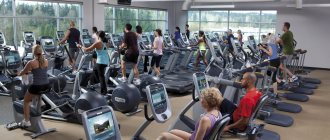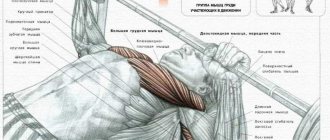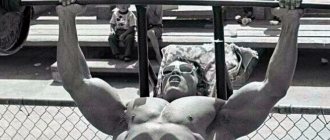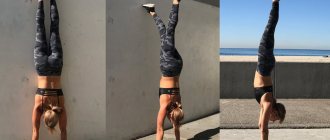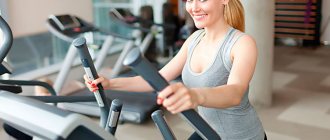What is the gym primarily associated with? Of course, these include exercise machines, treadmills, and a host of other highly specialized equipment. But in the center of everything stands it - bent from the weight of heavy discs, covered with scratches and abrasions from constant use, a battered barbell - like a queen in a chess game.
Those who are more or less seriously involved in bodybuilding know that without a barbell it is very difficult to effectively build muscle mass and, even more so, to develop strength indicators. After all, it is with its help that the famous three basic exercises are performed - deadlift, squats and bench press - without which bodybuilding, powerlifting, and classical weightlifting are unthinkable.
What to do when a pandemic is raging around you, but you don’t want to break quarantine and expose yourself and others to unnecessary risk? Of course, you can switch to another sport or quit training altogether until better times. But wouldn't it be better to get your own barbell and return to the gym in great shape? Or even switch to home workouts altogether - no longer depend on anyone and exercise at any convenient time right at home!
Type
A barbell is a sports equipment designed for lifting weights in weightlifting, bodybuilding and powerlifting.
The barbell consists of a bar (rod) on which discs (plates) are hung on both sides. Dumbbells are a sports equipment that is used for strength exercises with weights.
Dumbbells are divided into the following types.
Solid cast - have a given weight, consist of two balls (hexagonal prisms) connected to each other by a handle for gripping by hand. Note that the hexagonal shape of the dumbbell prevents it from rolling on the floor.
They can be made of solid metal or in the form of a plastic dumbbell with filler. Metal dumbbells of light weight (up to 3 kg) are often made of rubber for ease of grip.
When choosing, you should remember that if a plastic dumbbell is dropped, there is a chance of breaking it, after which it will be completely unusable. Poor-quality rubberized dumbbells, after some time of intensive use, lose their original appearance, as the rubber bands burst and peel off.
Collapsible - are a smaller copy of a barbell: they consist of a short bar and discs attached to it. Advantage - they allow you to vary the load by screwing or removing the disks.
Important: collapsible dumbbells are convenient to store in a closet. In addition, dumbbell discs can be placed on the barbell, thus saving money.
A kettlebell is a sports equipment that is a metal ball with a handle. Used in kettlebell lifting.
Kettlebells are divided into the following types.
- Solid cast - have a fixed weight (4-40 kg in increments of 4 kg, as well as 48 and 56 kg). In kettlebell lifting, kettlebells with a weight of 16, 24 and 32 kg are used, that is, one-pound, one-and-a-half-pound and two-pound weights (1 pound ≈ 16 kg). Some weights are coated with rubber for sound insulation purposes.
- Collapsible - the lower part of such a weight can be detached, which allows you to vary the load in the direction of decreasing or increasing it.
Important: kettlebells with a wide handle are convenient, as you can freely grab them by the sides of the handle while performing various exercises.
Barbell- Collapsible dumbbell
- Weight
Description of the technique of classic squats with a barbell at home
Classic squats: feet shoulder-width apart, the barbell held in the hands behind the head at the level of the fifth cervical vertebra or slightly lower. You should not place the bar on your neck - this is a common mistake for beginners. Lean back with your pelvis, as if the person is about to sit down on a chair standing behind you. Perform a squat parallel to the floor, then return to the starting position with a perfectly straight back.
The optimal number of repetitions per approach is from eight to twelve. The exercise involves working with a weight with which the athlete does not have the strength to perform the exercise more than twelve times. The last execution should be difficult - this is evidence of a conscientious approach.
Type of rod
Home (amateur) barbell - has a short length and weight limits of up to 100-120 kg. Discs are used with a seat diameter of 25-26 mm. Well suited for amateur training with light weights. The advantage is a relatively low price.
“People’s” barbell – resembles “Olympic” bars, but can withstand up to 150 kg. Discs are used with a seat diameter of 50-51 mm. Not suitable for professional training.
Olympic barbell – used by professional athletes. It is manufactured using special technology and is characterized by increased strength. Withstands weights of 300, 500, 600 kg and above. Discs with a mounting hole diameter of 50-51 mm are used.
- The women's Olympic barbell differs from the men's barbell by having a shorter bar (205 cm), lighter weight (15 kg) and diameter (25 mm).
A powerlifting barbell looks like an Olympic barbell, but the diameter of the bar is 29 mm and it is much more rigid.
Dumbbells and weights are also divided into amateur and Olympic (professional). They differ mainly in weight.
Important: be sure to pay attention to the maximum permissible load for the bar and never exceed it.
Barbell training at home: trainer's advice
Fitness neophytes often begin their workouts with excessive zeal and end up with injuries to their knees, joints, and spine. As a result, rarely does anyone return to training. To prevent this from happening, you need to increase the load gradually and learn the technique of basic exercises in front of a mirror.
Three workouts a week is enough. Only after a year or a year and a half of regular training can you radically increase the load and move on to four to five workouts per week. Otherwise, it is easy to provoke the so-called overtrain - chronic fatigue of the nervous system due to constant physical fatigue.
Vulture
The barbell is a metal rod of various diameters. Discs are put on its ends, and the base serves to hold the barbell in your hands. The load is secured using bushings and locks.
A dumbbell bar is a smaller version of a barbell bar.
Form
The shape of the bar is selected based on the exercises being performed.
Direct is a universal option. Suitable for most exercises.
EZ-Shaped – Provides a more natural wrist position for barbell curls.
W-shaped - an improved version of the EZ-bar. It differs from it in a stronger bend, which allows you to hold the barbell with a neutral grip and emphasize the load on the triceps. The best option for performing French presses and other similar exercises.
T-shaped - differs from a straight bar in that discs are hung on one end of it, and the second end of the bar is fixedly attached to a rack. Used for back exercises.
Trap bar - looks like a square frame with working areas on the sides. Designed for deadlifts, etc.
Oval – parallel grip bar. Used for triceps exercises (eg French press).
Important: “trying on live” will help you choose the right bar: evaluate the ease of performing exercises with different grips. The barbell should fit well in your hand.
Barbell at home – is it worth the trouble?
The barbell is a special piece of equipment. On the one hand, it has many disadvantages when training at home - these are large dimensions, high price, and danger if the exercise technique is performed incorrectly. But on the other hand, not a single piece of equipment, be it dumbbells, weights, expanders, or working with your own weight on the horizontal bar, can compare with a barbell in terms of:
- the number of muscles involved in the work. A weightlifter uses not only the main muscle groups - the back, legs, chest or shoulders - but also a huge number of small ones - stabilizers and rectifiers, extensors and flexors, which even have names only in Latin! And this is: harmoniously built body, the development of not only muscle strength, but also coordination, flexibility, ligamentous apparatus, and concentration.
- energy expenditure during training. This is especially important when working on weight loss and definition - with one exercise we work several muscle groups at once, we spend a lot of calories, but we get tired much less than training each part of the body separately.
- hormonal response. huge doses of testosterone enter the bloodstream , responsible for muscle growth and adaptation of the body to stress. This is where the feeling of “ muscle joy ” comes from after a workout - many hormones have a euphoric effect, which is necessary for us to feel less pain and fatigue from overload.
- psychological sensations from classes. Even the toughest bodyweight workouts don't give you the same sense of accomplishment as lifting a barbell. Most likely, this phenomenon is still prehistoric. Like, he blocked the entrance to the cave with a huge stone, dragged a massive tree for a fire, dumped a mammoth in a pit with stakes - get a reward in the form of a dose of dopamine , warm yourself, eat your fill and rest in safety!
In general, if the space in your apartment, your level of training, and your wealth allow it, it’s worth purchasing a barbell for home use!
What exercises can you do?
The barbell is used in basic exercises that are the foundation of strength training. The “base” will warm up the body as much as possible, cause a surge of hormones, saturate the muscles with blood and allow you to achieve a much greater effect from exercises on individual muscles.
- Deadlift is the foundation of weightlifting! An indispensable exercise that allows you to maximally load your lower back, buttocks and hips, strengthen your core, and improve your posture. The deadlift requires as much weight as possible to ensure that the large, powerful muscles in your lower body receive enough challenge. The deadlift alone makes it worth purchasing a barbell , it is so effective in terms of muscle growth.
- Squats with a barbell on your shoulders or in front of you. The best exercise for the legs, second only to the deadlift in terms of the number of muscle fibers involved and hormones released! The entire thigh is worked, especially its front part - the quadriceps, as well as the buttocks, lower back and calves, increasing the explosive strength and stability of the body. Exercise activates blood supply to the pelvic organs, which has a positive effect on the reproductive and reproductive systems of both sexes!
- Bench press. Undoubtedly the most popular exercise among men in all gyms around the world! No “bench press” - no powerful sculpted chest, voluminous arms and strong shoulders , wide chest and many other bonuses! At home, for this exercise you will also need a special bench and racks (or someone who will give you a barbell at outstretched arms).
- Army bench press. A basic exercise for the shoulders, powerfully loading all three bundles of deltoid muscles, trapezius, back, and neck. It can also be performed with dumbbells or kettlebells, but the barbell for the military press is most effective , as it prevents the arms from moving too far apart and “walking” relative to each other, and evenly distributes the load between the right and left – often lagging – shoulder.
- Bent-over barbell row. The best exercise for the lats and upper back for those who cannot do pull-ups with a wide grip! The deadlift will allow you to develop massive “wings”, form a beautiful V-shaped torso, and increase the strength of your forearms and palms. When performed with a reverse grip, it works the biceps well .
- Curls with a barbell in front of you. You can bend your arms while standing or sitting, as well as on a Scott bench or a special desk. A straight bar increases the overall strength and volume of the biceps , and a curved bar – EZ- or W-shaped – will also allow you to work the forearm muscles by holding the barbell with a pronated or “hammer” grip.
In addition to the “base,” the barbell can be used for a variety of isolation exercises. These are, for example, shrugs for the development of trapezius, French press for triceps, pullover for the chest and upper back, calf raises for the calf muscles and much more. With a well-chosen barbell, you can give an excellent load to the whole body . And if you add to this apparatus a horizontal bar with parallel bars, a hyperextension machine and a press machine, the training will be no less effective than in a full-fledged gym!
Neck dimensions
Length
The length of the bar depends on the exercises performed and training conditions. For example, a bar that is too short cannot be grasped with a wide grip for the bench press, while a bar that is too long can make it awkward to train indoors. The barbell has different lengths: 120, 140, 150, 180, 220 cm.
For comfortable and effective training at home, you will need a bar from 140 cm (with the length of the central part - 100 cm, the side parts for weight plates - 20 cm) to 180 cm. The bar for the Olympic barbell is 220 cm.
The length of the dumbbell bar also depends on the training conditions. It is impossible to put a large number of weights on a bar that is too short, which means increasing the load. A bar that is too long is inconvenient for many exercises. The bar of amateur dumbbells is 36 cm, the Olympic bar is 50 cm long.
Important: it is better to choose dumbbells with a rubberized handle (neck). This makes them pleasant to the touch and prevents them from slipping out of your hands. The bar has special notches that make the surface of the bar embossed and less slippery.
Diameter (thickness)
The diameter of the bar for an amateur barbell is 25 mm, for an Olympic barbell – 28 mm, for powerlifting – 29 mm.
The diameter of the bar (seat) for dumbbells in Europe and Russia is 30 mm, the American standard is 25 mm (for amateurs). The diameter of the seat of the bar of Olympic dumbbells is 50 mm.
Important: when purchasing a barbell and collapsible dumbbells, you should choose discs that are suitable for both equipment. To do this, you need to pay attention to the diameter of the barbells and dumbbells - it must be the same size. It should also be taken into account that the seat diameter of the pancakes is 1 mm larger than the diameter of the neck.
Weight
The weight of the bar depends on its length and diameter, as well as the density of the steel. A stronger bar has more weight and greater load capacity. The weight of the bar is also an additional burden for the athlete. The weight of the bar for an amateur barbell is 10-20 kg, for an Olympic barbell (powerlifting) - 20 kg, for a squat bar - 30 kg.
Important: the barbell for home training must have sufficient rigidity and not spring back when lifting heavy weights.
Barbell squats at home
Squats are a basic exercise that are quite difficult to perform. Despite its complexity, every beginning athlete should master it perfectly. Without regular squats, it is impossible to achieve muscular legs and rounded buttocks. By the way, this is also a favorite exercise for girls: it is with its help that you can “pump up” your Brazilian shape.
Improper squatting technique can lead to knee and joint injuries. To avoid this, at first the exercise should be performed only under the supervision of an experienced trainer. The main rule: when squatting, the knees should not “peek” over the toes, this leads to a shift in the center of gravity. As a result, the balance of the axial load on the spine is disrupted. Incorrect squatting technique and extremely heavy weights are guaranteed to lead not only to knee injuries, but also to problems with the spine.
Discs
Discs (plates) are additional weights that are placed on the barbell. They differ from each other in weight and diameter.
There are several types of disks.
Fitness discs are the most common. As a rule, they are painted black.
Olympic - used for professional sports. Discs of different weights differ from each other in color (red, green, yellow, black). There are the following types of such disks:
- rubberized models - absorb shock, are comfortable to hold in your hands and carry when changing weight;
- without rubber coating - used for powerlifting .
Diameter
The outer diameter is the size of the disc itself. Depends on its weight: the greater the weight, the larger the diameter.
Internal (landing) diameter - the size of the hole for the neck. The compatibility of the barbell and discs depends on this value. There are diameters of 26, 30 and 50-51 mm.
Weight
Barbell discs have different weights (0.25, 0.5, 0.75, 1.25, 2.5, 5, 10, 15, 20, 25, 50 kg). The most common are 2.5, 5 and 10 kilogram pancakes. In powerlifting, discs weighing 50 kg are used. Olympic bar discs are used by professional athletes and therefore have a particularly precise weight.
Important: for basic loads, you should purchase a pair of 20 kg disks, and then add weights of 1, 2.5, 5 and 10 kg. This will make it possible to smoothly increase or decrease the weight of the barbell.
It is inconvenient to use large diameter discs for dumbbells. Pancakes weighing no more than 5 kg are good. It is also recommended to have small disks of 0.5 and 1 kg in order to smoothly increase or decrease the load.
How much does a barbell weigh?
Straight and curved rods are available in various weights. This is important for how much weight you will lift. The total weight of the barbell is the weight of the bar and the weight of the plates you installed on the bar.
The Olympic straight bar usually weighs 20.4kg. There are also lighter bars that weigh 15.9 kg. The curved bar weighs from 11.3 to 13.6 kg. The discrepancy in weight is due to the fact that a w-shaped bar is shorter in length than a straight barbell.
Neck and disc material
The bar for a barbell (collapsible dumbbell) is made of metal. Olympic bars and powerlifting bars are made of high-strength steel and using special technology.
Metal disks are the simplest and cheapest option. However, they are susceptible to corrosion, can scratch the skin and deform the floor covering.
Metal discs with a rubber strip along the rim do not deform the floor, but are also susceptible to corrosion. Disadvantages: rubber has an unpleasant odor and can leave marks on the floor.
Metal discs completely covered with rubber/plastic are the best option: they are not subject to corrosion, do not deform the floor, and are durable. Disadvantages: high price, unpleasant smell of rubber and marks on the floor. In addition, the plastic may burst or crack if dropped on the floor.
Fastenings
A lock and nut are the most reliable fastening options, but the disadvantage of the nut is that it will take a long time to turn it due to the long landing section of the rod.
Typically, a barbell has three types of fastening - lock, nut and clamp. The most convenient options that require minimal time investment are locks and clips, also known as clothespins. The most reliable are locks and nuts: with them the pancakes will be well fixed. Obviously, in these two parameters, locks outperform other types of clamps, but they have another disadvantage - they lose in price.
Nuts Clamps Locks
If we were to prioritize the choice, we would give preference to locks, then nuts, and last of all, clamps. After all, safety is more important than convenience.
Locks (clamps)
Locks (clamps) are devices that secure the disc to the bar.
- Threaded ones are strong and reliable, but fixation will require additional time.
- Clothespins - quickly fix, but weaken over time and therefore it is necessary to monitor their reliability (especially on dumbbells).
- Locks for Olympic bars are the most reliable and easy to disassemble and reassemble. The disadvantage is the high price.
For collapsible dumbbells, the locks used are the same as for barbells.
Varieties of deadlift
The deadlift is a basic multi-joint exercise. Allows you to pump your back: the latissimus and trapezius muscles, as well as the biceps of the thigh (the back of the leg). Indirectly includes the gluteus maximus muscle, calves, triceps, and rectus peritoneum muscle.
Training at home with a barbell must include this exercise, and it is better to perform it in front of a mirror to learn the correct technique.
Manufacturer
You should not buy dumbbells and barbells of unknown brands. In terms of price, they can be noticeably more profitable than branded shells, but they have a number of disadvantages. For example, rubberized models may have a very strong odor that does not disappear over time. Using such dumbbells or weights at home is simply impossible. Also, the rubberized coating on the cheapest dumbbells often cracks and peels off.
When choosing dumbbells or barbells, you should pay attention to branded products. Even if they are local or Chinese brands, they will in any case be better than “no-name”. The most famous manufacturers: Alex, Eleiko, FitLogic, Foreman, Hop-Sport, HouseFit, Inter Atletika, Newt, Stein, USA Style, Vadzaari, Joerex, Kettler, Sprinter, Torneo, Stroy-Sport. As well as the world famous Adidas, Reebok and Nike. It is worth noting that the price of their products may be inflated due to the promotion of the brand. It is worth remembering that high-quality set dumbbells or barbells cannot be cheap.
Let's summarize: what should the barbell be like?
First you need to decide on your own capabilities, training goals, body condition and available finances. If you will be working out at home, and your home is not so large in size, then in this case you should choose a shortened barbell. A barbell with a straight bar is considered universal because it allows you to work with all muscle groups. You should compare your capabilities with the goals that you set for yourself in the classroom. If you are just starting to play sports seriously, then agree with a trainer who will show you how to do the exercises correctly and develop the necessary program, then you can practice on your own.
Before you start training hard, be sure to make an appointment with your doctor and make sure that such loads are not contraindicated for you - after all, if you have problems with your back or joints, then perhaps not all exercises will be safe to perform.
You should not buy barbells from unknown manufacturers, otherwise you risk your health and wallet. They will be more affordable in price than branded ones, and the quality may not meet the standards.
In our online store you have the opportunity to get professional advice from specialists based on your needs. We will offer you the best prices and fast delivery! It’s easy and simple to buy weights for a barbell or buy a barbell for a barbell from us. Our selection of sports goods will simply stun you! The best brands in this area are represented across our entire product line. Waiting for you!
Accessories
Have you figured out which barbell to choose for your home? That's not all! In addition to the training bar itself, the following accessories may be useful to you:
- A secure stance will help you do unassisted workouts, such as doing bench presses without having to lift the weight off the floor.
- Sports gloves are useful to protect your palms and improve your grip strength. Some models also allow you to strengthen your wrists, which will be useful for some athletes.
- Additional fingerboards are also good for improving grip strength. Some types of pads will help increase the thickness to work the wrist muscles.
- A special case will help you hide your equipment and free up space in the house; it will also be useful when moving.
barbell home workoutbarbell
Guide to Buying an Exercise Barbell with Weights
Cheaper booms do not spin as smoothly as higher quality booms
Higher quality bearings or bushings, as well as attention to detail and craftsmanship in high quality bars, allow the arm to rotate smoothly during both fast and slow lifts.
If you've ever dealt with an old, cheap barbell, you've no doubt noticed that the arms have been locked in place and no longer rotate. This is the fate of most cheap barbells.
High-quality rods, however, will maintain their appearance year after year.
Cheaper rods have larger diameter grips - meaning it's harder to grip
Cheaper rods are made from low-quality materials and in order to bring the weight of the rod to the standard 20 kg, some manufacturers need to make the diameter of the rods thicker.
Wider and thicker diameters make the barbell more difficult to grip. Not to mention that low-quality metal rods are not as durable.
Cheap barbells can be bent and sometimes broken in half
Cheaper rods are made from low-quality metals that bend more easily and are not as flexible as high-quality steel.
Usually a cheap barbell bends when overloaded, rather than breaking. But there have been cases when cheap rods broke in half, which can be very dangerous.
Bottom line: Allocate as much of your barbell budget as you can, this is where your home gym investment pays off the most
.
Speaking of cheap bars, have you realized that cheap collars aren't doing you any favors either?
Barbell collars hold the weight securely in place, and the best barbell collars are easy to remove, making it easier to change the weight.
